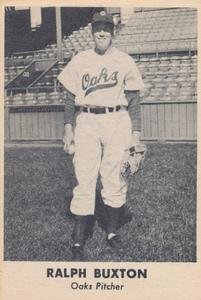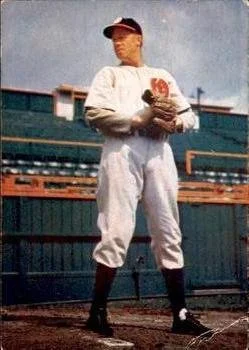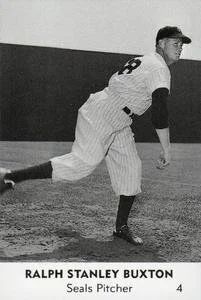Glew: Ralph Buxton: First Saskatchewan-born major leaguer
Ralph Buxton (Weyburn, Sask.) with the Philadelphia A’s in 1938.
January 19, 2023
By Kevin Glew
Canadian Baseball Network
He played on a World Series-winning team with Joe DiMaggio and Yogi Berra and pitched for Hall of Fame managers Connie Mack and Casey Stengel.
However, with the way umpires check pitchers for substances today, Ralph Buxton, the man sometimes referred to as the “Pine Tar Baby,” would’ve been in trouble.
But that’s all part of the story of this little-talked-about right-hander, who in 1938 became the first player born in Saskatchewan to compete in the major leagues.
Before you read too far, let’s be clear that while Buxton was born in Weyburn, Sask., on June 7, 1911, his family emigrated to the United States 17 months later with a declared destination of Los Angeles, Calif.
What inspired his farming father, Bert, and his mother, Florence, to pick up and head for the Golden State is a mystery. Los Angeles wasn’t what it is today, but it’s still hard to imagine a more dramatic lifestyle shift than moving from rural Saskatchewan to a burgeoning entertainment metropolis.
Buxton was the second youngest of four children and all were born in Weyburn. So, from this we can conclude that the Buxton family lived in Saskatchewan for at least the six-year period from 1907 to 1913 when records show the children were born.
In the 1920 U.S. Census, Buxton’s father is listed as a mechanic in Los Angeles, so he appears to have adapted to city life.
Buxton attended high school in Long Beach, Calif., where the 5-foot-11 right-hander was a standout on the diamond. He eventually earned a contract with the Ponca City Angels of the class-C Western Association in 1934, where he won 16 games as a starting pitcher before being promoted to the Los Angeles Angels of the Pacific Coast League.
He returned to the Angels the following year and for part of 1936 prior to moving on to Oklahoma City in the Texas League for two seasons. After going 13-9 with a 3.70 ERA in 36 games (30 starts) in 1937, he was selected by Connie Mack’s Philadelphia Athletics in a minor league draft.
Buxton spent the bulk of the next season with the A’s class-A Williamsport Grays, but he was called up by the A’s in September. He made his major league debut on September 11, 1938 against the Boston Red Sox at Fenway Park. He entered the game in relief in the fourth inning and allowed four runs on eight hits in 3 1/3 innings to a lineup that included Hall of Famers Jimmie Foxx, Joe Cronin and Bobby Doerr. The 27-year-old righty was saddled with the loss in the Red Sox 12-7 victory.
He’d make four more relief appearances for the A’s that season, permitting just one more earned run to finish with a 4.82 ERA in 9 1/3 innings.
That November, the A’s traded Buxton to the Pacific Coast League’s Oakland Oaks, with whom he’d begin a long association. Employing his trademark screwball, he never had less than 11 wins, pitched less than 183 innings or registered an ERA higher than 3.52 in any season between 1939 and 1943 for the Oaks.
He had developed into a reliable top-of-the-rotation starter when he was called for military duty in October 1943. He would spend at least part of his service in the Navy at the Mayport Base in Jacksonville, Fla.
Upon being discharged on December 19, 1945, Buxton rejoined the Oaks and pitched as both a starter and reliever. In 1948, he went 13-3 with a 3.19 ERA in 34 appearances, primarily out of the bullpen for Casey Stengel, the Oaks manager, and was the winning pitcher in the Oaks’ championship-clinching game.
But that season was not without its controversy. By this time, it was hardly a secret that Buxton was doctoring baseballs. He did it by adding pine tar, which was reportedly a widespread practice at the time.
On August 14, 1948, with the Oaks locked in a pennant race with the neighboring San Francisco Seals, Seals manager Lefty O’Doul waited until there were two outs in the ninth inning with his team trailing 4-3 to ask the umpires to check Buxton for pine tar. Sure enough, the umpires discovered a glob of the substance on the heel of Buxton’s glove.
To O’Doul’s chagrin, however, the umpires did not eject Buxton, but rather ordered him to get another glove. The Seals manager was furious and played the game under protest.
Pacific Coast League president Clarence Rowland would later suspend Buxton for 10 days (eight games) and order the final half inning of the contest to be replayed. Five weeks later, the Oaks and Seals met to repeat that half inning but it didn’t change the score.
Buxton, for his part, couldn’t understand the fuss.
“O’Doul has three pitchers that use it, too,” he told reporters about the pine tar.
Buxton with the Oakland Oaks
But Buxton seemed to use it most overtly. There are even reports of him boasting to a reporter before the game against the Seals about using it. To some, he became known as the “Pine Tar Baby.”
“Ralph Buxton – he used so much pine tar. He stuck it on his pants along the crease,” John Babich, a former Oaks coach, would later say. “All he’d do is rub his hands on his pants. He never used resin. He always used pine tar. He had it in his hip pocket all the time, which was a good deal because he used to throw the sinker and that’s the only way he could do it. Oh, what a relief pitcher he was.”
And when pine tar wasn’t enough, Buxton would add another substance.
“He also used a little bit of spit on his out pitch. When he threw it, it was like throwing through rain,” wrote Charlie Metro, a former Oaks teammate, in his book Safe By A Mile.
The scandal didn’t diminish Buxton in the eyes of Oaks supporters. He remained a fan favourite in the city.
After leading the Oaks to a Pacific Coast League championship in 1948, Stengel was hired to manage the New York Yankees and he didn’t forget the reliable Buxton.
Buxton with the New York Yankees.
Buxton started 1949 with the Oaks but was signed by the Yankees on July 22. And 11 years after his last big league appearance, a 38-year-old Buxton returned to The Show.
The crafty right-hander would register a 4.05 ERA in 14 relief appearances down the stretch for the Yankees, throwing primarily to Yogi Berra, with Hall of Famers Phil Rizzuto and Joe DiMaggio playing behind him. The Yankees edged out the Boston Red Sox to capture the American League pennant and then downed the Brooklyn Dodgers in five games to win the World Series.
Buxton was on the Yankees roster for the Fall Classic, but he did not pitch. After the season, the Yankees voted him three-quarters of a World Series share which amounted to just over $4,249.
Unfortunately for Buxton, just five days after the Yankees claimed the championship, they released him.
Ironically, it was O’Doul and the San Francisco Seals, who just over a year earlier had so vigorously protested his pine tar use, who signed him for the 1950 season. He’d make his final 38 pro appearances for the Seals.
Buxton, who officially became a U.S. citizen in 1951, finished his professional career with 165 wins in 500 minor league games. In 19 big league contests, he posted a 4.25 ERA.
He and his wife, Norma, who was also born in Canada, settled in San Leandro, Calif. They didn’t have any children.
In his post-playing days, Buxton worked as a metalsmith and enjoyed fishing and golfing.
Norma passed away in 1979 in San Leandro, Calif., and Buxton died in the same city nine years later.
In 2008, 20 years after his death, he was inducted into the Saskatchewan Baseball Hall of Fame.





